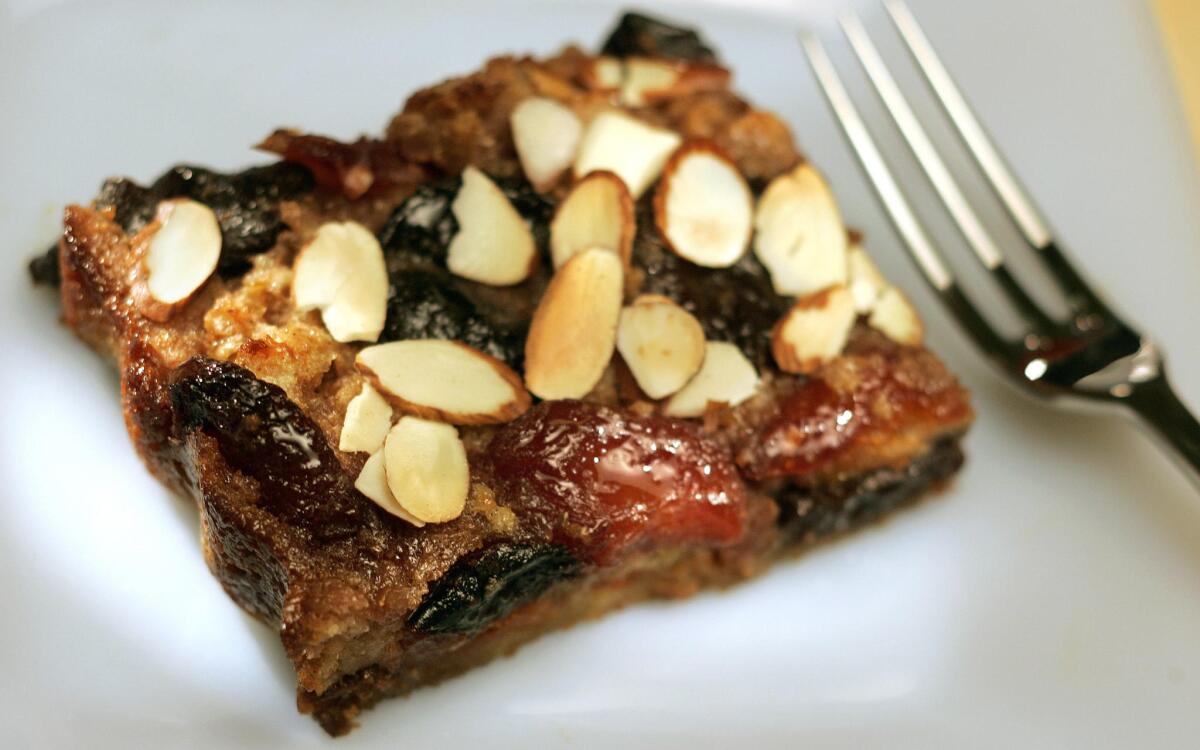Bread pudding with prunes and dried apricots

Alchemists have tried for centuries to transform base metals into gold -- unsuccessfully, at least as far as we know. But it’s a lovely concept: Take the common and uninspiring -- lead, copper, prunes -- and change it into something glorious.
Prunes?
Though dried fruit can be tasty right out of the box -- the lunchbox anyway -- it’s even better with a little transformation. But you don’t need medieval textbooks to do it; all you need is a well-stocked pantry, or even better, a good liquor cabinet.
Because to transform dried fruit from an ordinary snack into something quite astonishing, all you need to do is to macerate it -- soak it, that is, preferably in something interesting.
Maceration is really just a nice Latinate word for soaking a solid food in liquid, usually an alcohol. In the case of dried fruit, what happens is quite magical: The fruit, highly concentrated already, absorbs the liquid and effectively rejuvenates.
The flavors of the liquid meld with those of the fruit, creating an entirely new component with a different texture and entirely different flavor profile than you started with.
You can macerate currants in Bourbon, or soak apricots in tea. You can simmer dried figs in red wine and vanilla, or soak prunes in Armagnac.
What you use to macerate the fruit in depends on how you want the flavors to work: Different kinds of tea, wines, fruit juices, eaux de vie, liquors and liqueurs, even more exotic things like orange flower water or rosewater, all add different flavors to the fruit, as well as depth and complexity.
The fruit can be used in savory dishes, such as braises and pilafs, but where this method really shines is in desserts. The condensed flavors of the fruit blend with the sharper tones of the liquid -- especially if you use something with alcohol or tannin -- which not only adds dimension, but cuts the sweetness. The key in some of the best combinations is the tension between the flavors and the textures.
Bread pudding, like this one from Simone Beck, is a perfect example of this kind of tension. The thick whole fruit -- apricots and prunes redolent of red wine and cinnamon -- is the textural opposite of the baked country bread. The flavors all blend gorgeously.
Lindsey Remolif Shere, pastry chef at Chez Panisse from its opening in 1971 to her retirement in 1998, also likes to mix fresh fruits into dried fruit compotes. The principle is the same as with the bread pudding: a marriage of opposites. In this case, the fresh fruit leavens the intensity of the dried fruit, adding a nice counterpoint to the richness as well as to the texture and flavor.
Pair her recipe for spiced figs with poached fresh pears, and you can see what she means. The fig compote, with its thick syrup of reduced wine and black peppercorns, orange and allspice, plays off the fresh flavor of the pears, which balance the figs’ richness.
And then there’s prune and Armagnac ice cream, which is a study of balancing opposites. This is one of those dishes that you don’t think twice about -- until you realize that it’s a classic. Thomas Keller, Alice Waters and Paula Wolfert all include it in their cookbooks. And it’s a favorite on the menus of Chez Panisse in Berkeley and Bouchon in Napa Valley. Not bad for spiked vanilla ice cream and prunes.
The sophisticated precursor to rum raisin, this ice cream is another example of the attraction of opposites.
But there’s something about this dish that makes it exponentially more than the sum of its parts. Keller’s version uses creme fraiche, adding a lovely twang that further counters the sweetness of the prunes. The Chez Panisse variation adds a heftier shot of Armagnac.
The result is brilliant in the same way that cheese is brilliant with red wine, and for the same reason. The Armagnac cuts through the creamy richness of the ice cream. And in Wolfert’s hands, the dish takes an added dimension, thanks to the country French treatment she gives the prunes. First steeped overnight in linden or camomile tea, they’re then soaked in Armagnac -- with an addition of a little simple syrup -- for at least two weeks. In effect, they’re macerated not once, but twice, and in two very different liquids. The flavor is much smoother, which keeps it from overwhelming the ice cream’s subtle vanilla. And the effect is amazing: The prunes are much softer in texture, and thus blend far better into the ice cream.
Beats rum raisin any day.
To plump the prunes and apricots, place them in a medium saucepan with the wine or tea and cinnamon. Cover and simmer until the fruit is very tender and has absorbed most of the liquid, about 15 to 20 minutes.
Soak the bread briefly in the milk, then add it to the pan, off heat, along with the sugar, butter, orange zest, eggs and rum, if using. Stir gently to combine.
Turn the mixture into a well-buttered 1 1/2 -quart Pyrex casserole or a medium-size oval gratin dish and bake in a 375-degree oven for 15 minutes.
Sprinkle on the sliced almonds and continue baking for another 15 minutes, or until the pudding is firm and the almonds are nicely browned. Allow to cool slightly before serving.
Get our Cooking newsletter.
Your roundup of inspiring recipes and kitchen tricks.
You may occasionally receive promotional content from the Los Angeles Times.
















